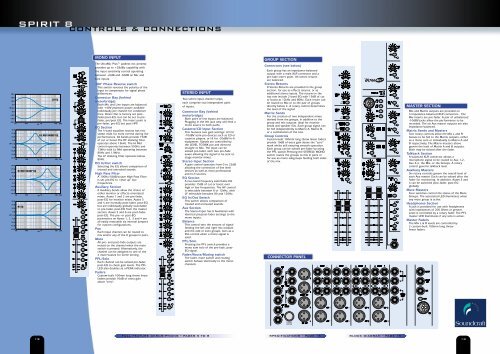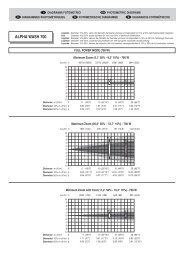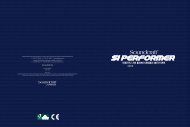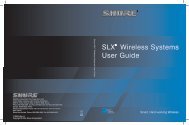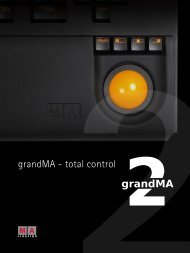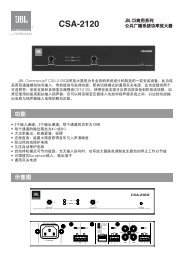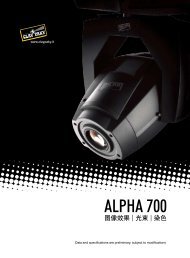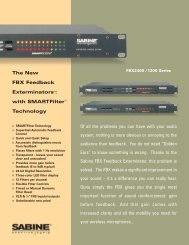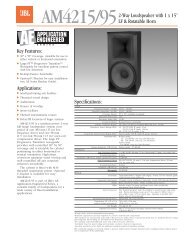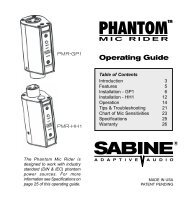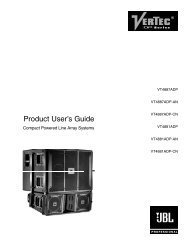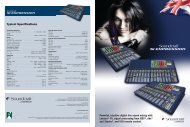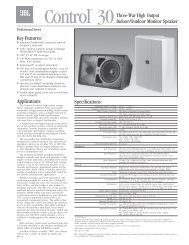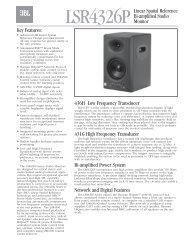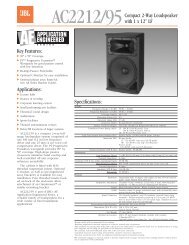LIVE RANGE BROCHURE LIVE MIXING CONSOLES ... - Soundcraft
LIVE RANGE BROCHURE LIVE MIXING CONSOLES ... - Soundcraft
LIVE RANGE BROCHURE LIVE MIXING CONSOLES ... - Soundcraft
Create successful ePaper yourself
Turn your PDF publications into a flip-book with our unique Google optimized e-Paper software.
SPIRIT 8<br />
CONTROLS & CONNECTIONS<br />
HI MID SWEEP EQ<br />
HI EQ<br />
LO EQ<br />
LO MID SWEEP EQ<br />
MONO INPUT<br />
The UltraMic Plus padless mic preamp<br />
provides up to +28dBu capability with<br />
the input sensitivity control operating<br />
between +6dB and -60dB on Mic and<br />
Line inputs.<br />
180° Phase Reverse switch<br />
This switch reverses the polarity of the<br />
input to compensate for signal phase<br />
differences.<br />
Connector Bay (behind<br />
meterbridge)<br />
Both Mic and Line inputs are balanced<br />
with +48V phantom power available<br />
individually per channel for condenser<br />
mics. Direct Out is factory set postfader/post-EQ,<br />
but can be set to prefader,<br />
pre/post EQ. The insert point is<br />
pre-fader, pre-EQ but post HPF.<br />
EQ Section<br />
The 4 band equaliser section has two<br />
swept mids for extra control during live<br />
performances. All bands provide 15dB<br />
of cut or boost.The HF shelving filter<br />
operates above 13kHz. The Hi Mid<br />
control operates between 550Hz and<br />
13kHz with Lo Mid operating between<br />
80Hz and 1.9kHz.<br />
The LF shelving filter operates below<br />
80Hz.<br />
EQ In/Out switch<br />
Selecting the EQ allows comparison of<br />
treated and untreated sounds.<br />
High Pass Filter<br />
A 100Hz/18dB/octave High Pass Filter<br />
is set pre-EQ to ‘clean up’ low<br />
frequencies.<br />
Auxiliary Section<br />
6 Auxiliary Sends allow the choice of<br />
either monitor or effects-orientated<br />
mixes. Auxes 1 and 2 are pre-fader,<br />
post-EQ for monitor mixes. Auxes 3<br />
and 4 are normally post-fader, post-EQ<br />
but are individually globally switchable<br />
to pre-fader, post-EQ from the master<br />
section. Auxes 5 and 6 are post-fader,<br />
post-EQ. The pre- or post-EQ<br />
parameters on Auxes 1, 2, 3 and 4 are<br />
all easily resettable via internal jumpers<br />
for custom configurations.<br />
Pan<br />
Each input channel can be routed to<br />
mix and/or any of the 8 groups in pairs.<br />
Mute<br />
All pre- and post-fade outputs are<br />
muted on the channel when the mute<br />
switch is pressed. Alternatively, the<br />
channel can be assigned to one of the<br />
4 mute busses for scene setting.<br />
PFL/Solo<br />
Each channel can be soloed pre-fader,<br />
post-EQ to check gain levels. The PFL<br />
LED also doubles as a PEAK indicator.<br />
Faders<br />
Custom-built 100mm long throw linear<br />
faders provide 10dB of extra gain<br />
above “zero”.<br />
STEREO INPUT<br />
Two stereo input channel strips,<br />
each comprise two independent pairs<br />
of inputs.<br />
Connector Bay (behind<br />
meterbridge)<br />
Both pairs of line inputs are balanced.<br />
Plugging in the left jack only will feed a<br />
mono source to both paths.<br />
Cassette/CD Input Section<br />
This features two gain settings: LO for<br />
-10dBV semi-pro devices such as CD or<br />
cassette players, or HI for -20dBV hi-fi<br />
equipment. Signals are controlled by<br />
the LEVEL TO MIX pot and directed<br />
straight to Mix. The input can be<br />
soloed pre-fader, with two pre-fade<br />
auxes allowing the signal to be sent to<br />
stage monitor mixes.<br />
Stereo Input Section<br />
A gain control operates from 0 to 22dB<br />
allowing the connection of line level<br />
devices as well as most professional<br />
and hi-fi sources.<br />
EQ Section<br />
A two band frequency switchable EQ<br />
provides 15dB of cut or boost over<br />
high or low frequencies. The HF control<br />
is selectable between 6 or 12kHz, with<br />
LF selectable between 80 and 120Hz.<br />
EQ In/Out Switch<br />
This switch allows comparison of<br />
treated and untreated sounds.<br />
Aux Section<br />
The Stereo Input has 6 Auxiliaries with<br />
identical pre/post-fader settings to the<br />
mono inputs.<br />
Balance<br />
This control sets the amount of signal<br />
feeding the left and right mix outputs<br />
and the odd or even groups. Acts as a<br />
Pan control when a mono signal is<br />
used.<br />
PFL/Solo<br />
Pressing the PFL switch provides a<br />
mono sum solo of the pre-fade, post-<br />
EQ signal.<br />
Fader/Route/Muting switch<br />
The fader, mute switch and routing<br />
switch behave identically to the mono<br />
channels.<br />
GROUP SECTION<br />
Connectors (see below)<br />
Each group has an impedance-balanced<br />
output with a male XLR connector and a<br />
pre-fade insert point. All stereo returns<br />
are balanced.<br />
Stereo Returns<br />
8 Stereo Returns are provided in the group<br />
section, for use as effects returns, or as<br />
additional stereo inputs. The returns in the<br />
top row include 2 band EQ with 15dB of cut<br />
or boost at 12kHz and 80Hz. Each return can<br />
be routed to Mix or to the pair of groups<br />
directly below it. A rotary control determines<br />
the level of the signal.<br />
Matrix Sends<br />
For the creation of two independent mixes<br />
derived from the groups, in addition to the<br />
group and mix outputs: ideal for monitor<br />
sends and speaker fills. Each group signal can<br />
be fed independently to Matrix A, Matrix B,<br />
or a combination of the two.<br />
Group Controls<br />
Custom-built 100mm long throw linear faders<br />
provide 10dB of extra gain above the “zero”<br />
mark whilst still ensuring smooth operation.<br />
Each group can be soloed pre-fader by using<br />
the PFL switch.Pressing the STEREO/ MONO<br />
switch routes the groups to mix in pairs or<br />
for use as mono subgroups feeding both sides<br />
of the mix.<br />
CONNECTOR PANEL<br />
MASTER SECTION<br />
Mix and Matrix outputs are provided on<br />
4 impedance-balanced XLR connectors . The<br />
Mix inserts are pre-fader. A pair of unbalanced<br />
-10dBV jacks allow the performance to be<br />
recorded. The six Aux master outputs are also<br />
impedance-balanced.<br />
Matrix Sends and Masters<br />
Two rotary controls allow the Mix L and R<br />
busses to be fed to the Matrix outputs, either<br />
as a mono sum or individually to Matrix A and<br />
B respectively. The Matrix masters above<br />
govern the level of Matrix A and B outputs.<br />
Both may be soloed after the fader.<br />
Talkback Section<br />
A balanced XLR connector allows a<br />
microphone signal to be routed to Aux 1-2,<br />
Aux 3-4, the Mix, or the Groups. A rotary<br />
control governs talkback level.<br />
Auxiliary Masters<br />
Six rotary controls govern the overall level of<br />
each Aux master. Each can be soloed after the<br />
fader for monitoring. In addition, Auxes 3 and<br />
4 can be switched post-fader, post-EQ<br />
globally.<br />
Mute Masters<br />
Four switches control the status of the Mute<br />
Groups. The associated LED illuminates when<br />
any mute group is active.<br />
Headphones Section<br />
A jack is provided for use with headphones<br />
with impedances of 200 Ohms or greater.<br />
Level is controlled by a rotary fader. The PFL<br />
master LED illuminates if any solo is active.<br />
Master Faders<br />
The Mix L & R levels are controlled by<br />
2 custom-built 100mm long throw<br />
linear faders.<br />
12<br />
FULL FEATURE DESCRIPTIONS – PAGES 5 TO 8<br />
SPECIFICATIONS – PAGE 15 BLOCK DIAGRAM – PAGE 15<br />
13


